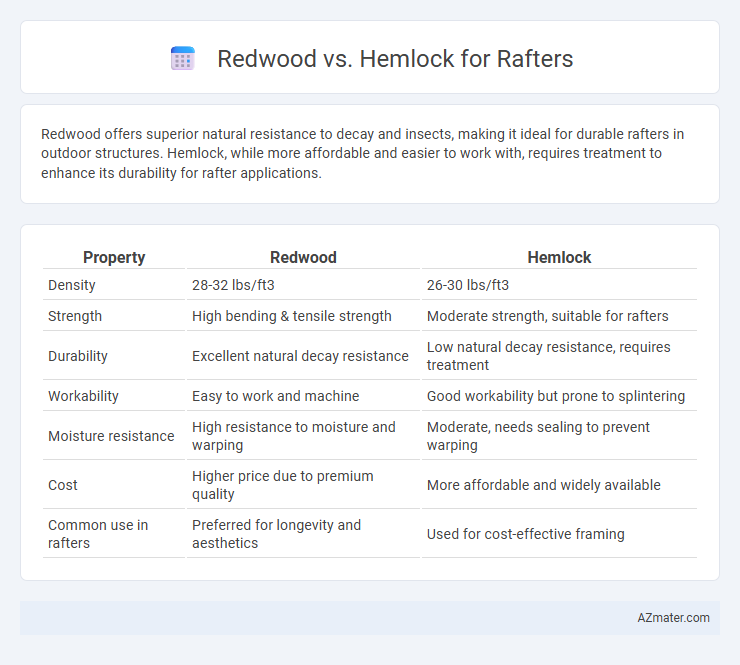Redwood offers superior natural resistance to decay and insects, making it ideal for durable rafters in outdoor structures. Hemlock, while more affordable and easier to work with, requires treatment to enhance its durability for rafter applications.
Table of Comparison
| Property | Redwood | Hemlock |
|---|---|---|
| Density | 28-32 lbs/ft3 | 26-30 lbs/ft3 |
| Strength | High bending & tensile strength | Moderate strength, suitable for rafters |
| Durability | Excellent natural decay resistance | Low natural decay resistance, requires treatment |
| Workability | Easy to work and machine | Good workability but prone to splintering |
| Moisture resistance | High resistance to moisture and warping | Moderate, needs sealing to prevent warping |
| Cost | Higher price due to premium quality | More affordable and widely available |
| Common use in rafters | Preferred for longevity and aesthetics | Used for cost-effective framing |
Introduction to Redwood and Hemlock for Rafters
Redwood rafters are valued for their natural resistance to decay, lightweight properties, and attractive reddish hue, making them a durable and visually appealing choice in construction. Hemlock, a versatile softwood, offers strength and affordability, with a straight grain that provides stability for rafters in various building projects. Both redwood and hemlock provide structural integrity, but redwood's superior resistance to moisture and insects makes it particularly suited for outdoor or humid environments.
Physical Properties Comparison: Redwood vs Hemlock
Redwood offers superior natural durability and resistance to decay compared to hemlock, making it ideal for rafters exposed to moisture. Hemlock tends to be stronger in bending and stiffness, supporting heavier loads under stress. Redwood's lower density provides easier workability, while hemlock's uniform grain offers consistent structural performance.
Durability and Lifespan of Redwood vs Hemlock Rafters
Redwood rafters offer superior durability due to their natural resistance to decay, insects, and moisture, often lasting 30 to 40 years or more with proper maintenance. Hemlock rafters, while generally strong and affordable, are more susceptible to rot and insect damage, typically providing a lifespan of around 15 to 25 years without enhanced treatment. The inherent durability of redwood makes it a preferred choice for long-lasting structural applications like rafters in outdoor or humid environments.
Strength and Load-Bearing Capacity
Redwood offers superior strength and load-bearing capacity for rafters compared to hemlock, exhibiting an average bending strength of around 8,900 psi versus hemlock's 7,200 psi. The high-density grain structure of redwood enhances its ability to withstand heavier loads and resist warping under stress. Hemlock, while lighter and easier to work with, provides lower rigidity and durability, making it less ideal for heavy structural applications.
Resistance to Decay, Rot, and Insects
Redwood rafters exhibit superior resistance to decay, rot, and insect damage due to their natural tannins and oils, making them an ideal choice for outdoor and moisture-prone environments. Western Hemlock, while structurally strong and affordable, lacks these natural preservatives and generally requires chemical treatment to enhance its durability against decay and pests. Selecting redwood can reduce maintenance costs and extend the lifespan of rafters in areas with high humidity and insect activity.
Workability and Ease of Installation
Redwood offers superior workability for rafters due to its straight grain and consistent texture, making it easier to cut and shape with standard woodworking tools. Hemlock, while slightly harder and denser, provides greater structural strength but may require more effort during installation to achieve precise fits and finishes. Both woods are common in framing, but redwood's lighter weight and natural resistance to splitting enhance efficiency during on-site assembly.
Environmental Impact and Sustainability
Redwood rafters offer significant sustainability advantages due to their natural resistance to decay and pests, reducing the need for chemical treatments and increasing longevity. Hemlock, while less naturally durable, is often sourced from fast-growing, sustainably managed forests, making it a renewable option with a lower carbon footprint when harvested responsibly. Both woods provide eco-friendly choices, but redwood's durability often translates to less frequent replacement, enhancing its environmental benefits over time.
Cost Analysis: Redwood vs Hemlock Rafters
Redwood rafters typically cost more than hemlock due to their higher durability and natural resistance to decay, averaging around $4 to $7 per linear foot compared to hemlock's $2 to $5 per linear foot. Hemlock offers a more budget-friendly option for structural framing but may require additional treatment to enhance its longevity. Cost efficiency depends on project scope, local availability, and long-term maintenance expenses.
Best Applications and Use Cases
Redwood is ideal for rafters in outdoor structures like pergolas and decks due to its natural resistance to decay and insects, ensuring long-lasting durability and minimal maintenance. Hemlock is favored for interior rafters or painted applications where strength and a smooth finish are required, offering a cost-effective and structurally sound option. Both woods perform well in framing, but redwood's superior weather resistance makes it the best choice for exposed, moisture-prone environments.
Conclusion: Choosing the Right Wood for Rafters
Redwood offers superior natural resistance to decay and insects, making it an ideal choice for rafters in humid or exposed environments. Hemlock provides a more affordable option with good structural strength but requires protective treatment to ensure durability. Selecting between redwood and hemlock depends on budget constraints and the specific environmental conditions of the building site.

Infographic: Redwood vs Hemlock for Rafter
 azmater.com
azmater.com